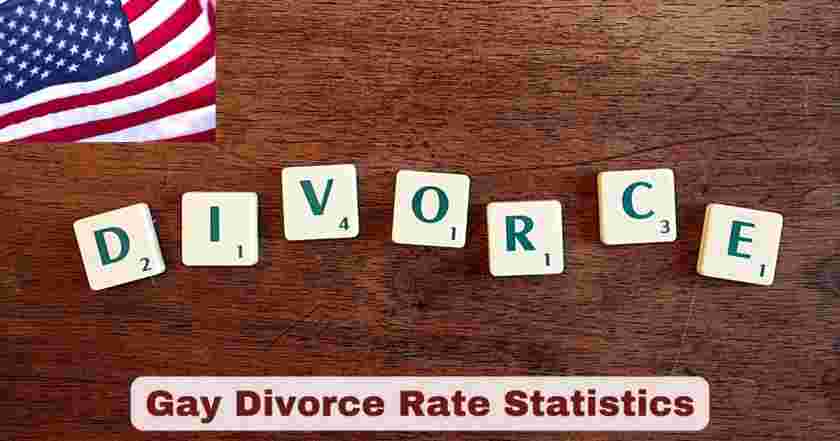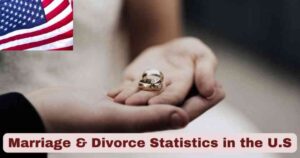Gay Divorce in the US 2025
The landscape of gay divorce in the United States has evolved significantly since the landmark Supreme Court decision in 2015 that legalized same-sex marriage nationwide. As we examine the gay divorce rate statistics, we see a complex picture that challenges many preconceptions about LGBTQ+ relationship stability. With 61% of same-sex couples now married compared to just 7.9% in 2009, the legal recognition of these unions has provided unprecedented data on relationship dissolution patterns within the gay community.
The current data reveals that gay divorce rates in the US are remarkably lower than many anticipated, with comprehensive studies showing an annual dissolution rate of approximately 1.1% for same-sex married couples. This statistic becomes even more significant when compared to the 2% annual divorce rate among different-sex couples, indicating that same-sex marriages demonstrate slightly greater stability. However, the gay divorce rate 2025 statistics show notable variations between lesbian and gay male couples, with distinct patterns emerging that reflect unique challenges and circumstances within each demographic.
Interesting Stats & Facts About Gay Divorce in the US 2025
| Gay Divorce Facts 2025 | Statistics |
|---|---|
| Annual Gay Divorce Rate | 1.1% |
| Overall Same-Sex Divorce Percentage | 5-6% |
| Lesbian Couple Divorce Rate | 34% |
| Gay Male Couple Divorce Rate | 16% |
| Average Marriage Duration Before Divorce (Female) | 4.7 years |
| Average Marriage Duration Before Divorce (Male) | 5.4 years |
| Same-Sex Couples with Children | 94,627 households |
| Lesbian Couples with Children Divorce Rate (5 years) | 12.3% |
| Increase in Same-Sex Divorces (2020 vs 2019) | 40.4% |
| Current Married Same-Sex Couples Percentage | 61% |
The gay divorce rate 2025 data reveals fascinating insights into relationship dynamics within the LGBTQ+ community. Perhaps most striking is the 1.1% annual divorce rate, which positions same-sex marriages as statistically more stable than their heterosexual counterparts. This challenges long-held assumptions and demonstrates that legal recognition has provided the framework for enduring partnerships. The stark difference between lesbian and gay male divorce rates tells an important story about gender dynamics and relationship patterns, with lesbian couples experiencing divorce at more than double the rate of gay male couples.
The statistics surrounding children in same-sex households paint a complex picture of modern family structures. With 94,627 same-sex households including children, parenting dynamics significantly influence relationship stability. The 12.3% divorce rate among lesbian couples with children within the first five years of marriage highlights the additional stressors that child-rearing can place on relationships, particularly when combined with the unique challenges faced by LGBTQ+ families in terms of legal recognition, social acceptance, and support systems.
Gay Divorce Trends in the US 2025
The gay divorce rate in the US 2025 reflects broader social and legal changes that have occurred over the past decade. Research from the Williams Institute, based on administrative data from eight states, provides the most comprehensive analysis available. Same-sex couples end their marriages at a rate of 1.1% annually, on average, which is slightly lower than the annual rate of divorce among different-sex couples, which is about 2% annually. This data fundamentally challenges assumptions about same-sex relationship stability.
The most recent gay divorce statistics 2025 show that while overall rates remain lower than heterosexual couples, there was a notable 40.4% increase in same-sex divorces in 2020 compared to 2019. This spike contrasts sharply with the 4.5% decrease in opposite-sex divorces during the same period, suggesting that external factors such as the COVID-19 pandemic, legal backlogs, or evolving social dynamics may have disproportionately affected LGBTQ+ couples. The data indicates that same-sex couples face unique stressors that can impact relationship stability during times of crisis.
Lesbian Divorce Statistics in the US 2025
| Lesbian Divorce Metrics 2025 | Percentage/Data |
|---|---|
| Overall Lesbian Divorce Rate | 34% |
| Lesbian Couples with Children (5-year divorce rate) | 12.3% |
| Average Years Before Divorce | 4.7 years |
| Legal Ground: Unreasonable Behavior | 55.2% |
| Legal Ground: Irreconcilable Differences | 30% |
| Legal Ground: Separation | 10% |
| Other Reasons (abuse, imprisonment) | 4.8% |
The lesbian divorce rate in the US 2025 presents a particularly complex picture within the broader gay divorce rate 2025 landscape. At 34%, lesbian couples experience divorce at significantly higher rates than their gay male counterparts, who divorce at a rate of 16%. This disparity reflects multiple factors including communication styles, emotional intensity, financial pressures, and the additional challenges of parenting within same-sex relationships. Research suggests that lesbian relationships often involve higher levels of emotional intimacy and interdependence, which can create both stronger bonds and greater potential for conflict.
The presence of children significantly impacts lesbian divorce statistics 2025, with couples who have children showing a 12.3% divorce rate within the first five years of marriage. This statistic highlights the particular challenges faced by lesbian mothers, who must navigate not only the typical stressors of parenting but also legal complexities around non-biological parent rights, social acceptance, and access to supportive services. The 4.7-year average duration before divorce among lesbian couples suggests that relationship stability is tested most severely during the early years of marriage, particularly when combined with child-rearing responsibilities.
Gay Male Divorce Statistics in the US 2025
| Gay Male Divorce Metrics 2025 | Percentage/Data |
|---|---|
| Overall Gay Male Divorce Rate | 16% |
| Average Years Before Divorce | 5.4 years |
| Legal Ground: Unreasonable Behavior | 57% |
| Legal Ground: Irreconcilable Differences | 28% |
| Legal Ground: Separation | 12% |
| Other Reasons (abuse, imprisonment) | 3% |
| Annual Dissolution Rate | 1.1% |
| Married Gay Male Couples (current) | Data varies by state |
| Financial Stability Factor | Higher income = lower divorce rate |
The gay male divorce rate in the US shows markedly different patterns compared to lesbian couples, with a significantly lower overall divorce rate of 16%. This substantial difference suggests that relationship dynamics, communication patterns, and external stressors affect gay male couples differently than lesbian couples. The 5.4-year average duration before divorce indicates that gay male marriages tend to last longer before dissolution, potentially reflecting different approaches to conflict resolution, financial management, and relationship expectations.
Gay male couples cite unreasonable behavior as the primary legal ground for divorce in 57% of cases, slightly higher than lesbian couples at 55.2%. However, the overall divorce rate remains substantially lower, suggesting that when gay male couples do divorce, the underlying issues may be more severe or that they are more likely to work through relationship challenges before reaching the point of legal dissolution. The gay male divorce statistics 2025 also indicate that financial stability plays a crucial role, with higher-income couples showing greater relationship stability, possibly due to reduced financial stress and greater access to relationship counseling and support services.
Factors Affecting Gay Divorce Rates in the US 2025
| Contributing Factors | Impact Level | Description |
|---|---|---|
| Minority Stress | High | Discrimination and social stigma effects |
| Family Support | High | Lack of family acceptance impacts stability |
| Legal Recognition | Medium | Access to marriage equality and legal rights |
| Financial Stability | High | Economic security affects relationship stability |
| Children Present | Variable | Can strengthen or stress relationships |
| Age at Marriage | Medium | Older couples show greater stability |
| Education Level | Medium | Higher education correlates with stability |
| Geographic Location | Medium | More accepting regions show lower divorce rates |
The factors affecting gay divorce rates reveal a complex interplay of social, legal, and personal elements that influence relationship stability. Minority stress emerges as one of the most significant contributors to relationship dissolution, encompassing the chronic psychological impact of discrimination, social stigma, and family rejection. This unique stressor affects LGBTQ+ couples disproportionately and can erode communication, trust, and emotional intimacy over time. The lack of family support, reported more frequently among LGBTQ+ individuals than their heterosexual peers, leaves couples more vulnerable to relationship instability without traditional emotional and financial backing.
The gay divorce rate is also significantly influenced by legal and logistical challenges unique to same-sex couples. Many couples have transitioned from domestic partnerships or civil unions to legal marriage, creating complex legal entanglements during divorce proceedings. Additionally, issues such as child custody, parental rights for non-biological parents, and asset division can be more complicated due to the relatively recent legal recognition of same-sex marriages. Geographic location plays a crucial role, with couples in more accepting regions experiencing lower divorce rates due to greater social support, legal protections, and access to LGBTQ+-affirming services.
Same-Sex Marriage Stability in the US 2025
| Stability Indicators | 2019 Data | 2025 Projections |
|---|---|---|
| Average Marriage Duration (Female) | 4.1 years | 4.7 years |
| Average Marriage Duration (Male) | 4.3 years | 5.4 years |
| Overall Divorce Rate | 5% | 5-6% |
| Public Support for Same-Sex Marriage | 55% | 61% |
| Same-Sex Couples Married | 58% | 61% |
| Legal Protections Available | Moderate | Strong |
| Access to Counseling Services | Limited | Improved |
| Workplace Discrimination Protection | Variable | Enhanced |
The same-sex marriage stability in the US 2025 shows encouraging trends toward greater relationship longevity and reduced divorce rates. The increase in average marriage duration before divorce, from 4.1 to 4.7 years for female couples and 4.3 to 5.4 years for male couples, indicates improving relationship stability over time. This trend likely reflects the normalization of same-sex marriage, improved access to legal protections, and growing social acceptance that reduces minority stress on couples.
The gay marriage stability 2025 data suggests that as legal and social barriers continue to diminish, same-sex couples are experiencing relationship patterns increasingly similar to their heterosexual counterparts. The growth in public support for same-sex marriage from 55% to 61% creates a more supportive environment for LGBTQ+ relationships, while enhanced workplace protections and improved access to counseling services provide couples with better tools for navigating relationship challenges. These improvements in the social and legal landscape are expected to continue driving down the gay divorce rate 2025 as couples benefit from reduced external stressors and increased support systems.
Regional Variations in Gay Divorce Rates in the US 2025
| Geographic Region | Divorce Rate | Contributing Factors |
|---|---|---|
| Northeast | Lower than national average | Strong legal protections, social acceptance |
| West Coast | Below national average | Progressive policies, LGBTQ+ resources |
| Southeast | Above national average | Limited legal protections, social challenges |
| Midwest | Variable | Mixed acceptance levels, urban vs rural divide |
| Mountain West | Moderate | Growing acceptance, moderate legal protections |
| Southwest | Near national average | Diverse attitudes, varying local policies |
| Rural Areas (National) | Higher rates | Limited resources, social isolation |
| Urban Areas (National) | Lower rates | Better support systems, acceptance |
The regional gay divorce rates in the US 2025 demonstrate significant geographic variations that reflect local attitudes, legal protections, and available resources. States in the Northeast and West Coast consistently show lower divorce rates among same-sex couples, benefiting from comprehensive anti-discrimination laws, robust LGBTQ+ support networks, and generally higher levels of social acceptance. These regions typically offer better access to LGBTQ+-affirming mental health services, legal resources, and community support systems that help couples navigate relationship challenges.
Conversely, the gay divorce rate 2025 tends to be higher in regions with limited legal protections or more conservative social attitudes. The Southeast shows particularly elevated divorce rates, reflecting the additional stress placed on same-sex couples by hostile social environments, limited legal recourse for discrimination, and fewer specialized support services. The urban-rural divide is especially pronounced, with rural same-sex couples facing isolation, limited resources, and reduced access to LGBTQ+-competent professionals. These geographic disparities highlight how external social and legal factors significantly influence relationship stability, with supportive environments correlating strongly with lower divorce rates among same-sex couples.
Legal Challenges in Gay Divorce Proceedings in the US 2025
| Legal Challenge | Frequency | Complexity Level |
|---|---|---|
| Child Custody Issues | High | Very High |
| Non-Biological Parent Rights | Very High | Extreme |
| Asset Division Complications | Moderate | High |
| Spousal Support Determinations | Moderate | Moderate |
| Interstate Recognition Issues | Low | High |
| Previous Union Dissolution | Moderate | High |
| Adoption Rights | High | Very High |
| Social Security Benefits | Low | Moderate |
| Healthcare Decision Rights | Moderate | Moderate |
The legal challenges in gay divorce 2025 reveal complex issues that same-sex couples face when dissolving their marriages. Child custody and parental rights represent the most significant challenges, particularly for non-biological parents who may struggle to maintain relationships with children they helped raise but lack legal recognition as parents. These cases often require extensive legal documentation and can result in costly court battles, contributing to both the emotional and financial stress of divorce proceedings.
The gay divorce legal issues 2025 are further complicated by the fact that many same-sex couples previously held civil unions or domestic partnerships before marriage equality. Dissolving these previous legal relationships while navigating current marriage dissolution creates additional legal complexity and expense. Interstate recognition issues, while less common following nationwide marriage equality, still arise when couples move between states with varying levels of LGBTQ+ legal protections. These legal challenges often require specialized attorneys familiar with LGBTQ+ family law, adding to the cost and complexity of divorce proceedings for same-sex couples compared to their heterosexual counterparts.
Future Outlook
The future outlook for gay divorce rates 2025 and beyond appears increasingly optimistic as social acceptance continues to grow and legal frameworks mature. With 61% of Americans now supporting same-sex marriage, up from 37% in 2009, the social environment for LGBTQ+ couples is becoming more supportive, which should contribute to reduced minority stress and improved relationship stability. The normalization of same-sex relationships in media, policy, and daily life is expected to further reduce the unique stressors that have historically contributed to higher divorce rates in some segments of the LGBTQ+ community.
Looking toward the future, several key factors are likely to influence the gay divorce rate trends 2025 and beyond. Enhanced legal protections, improved access to LGBTQ+-affirming support services, and the growing availability of specialized family counseling are all expected to contribute to greater relationship stability. As the first generation of couples married under full marriage equality ages, researchers anticipate that divorce patterns among same-sex couples will increasingly mirror those of heterosexual couples. The continued reduction of discriminatory practices in employment, housing, and healthcare will further minimize external stressors on relationships, while improved legal frameworks for issues like child custody and parental rights will reduce the complexity and stress of potential divorce proceedings.
Disclaimer: The data research report we present here is based on information found from various sources. We are not liable for any financial loss, errors, or damages of any kind that may result from the use of the information herein. We acknowledge that though we try to report accurately, we cannot verify the absolute facts of everything that has been represented.







